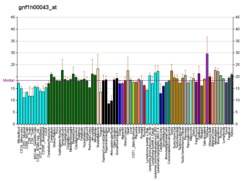DNAH11
Dynein heavy chain 11, axonemal is a protein that in humans is encoded by the DNAH11 gene.[5][6]
Function
This gene encodes a member of the dynein heavy chain family. It is a microtubule-dependent motor ATPase and has been reported to be involved in the movement of respiratory cilia. Mutations in this gene have been implicated in causing primary ciliary dyskinesia (PCD, formerly called 'immotile cilia syndrome') and Kartagener syndrome (PCD with situs inversus totalis). Males with PCD are not sterile, but are infertile due to lack of sperm motility.[6] There are reports of subfertility and increased risk of ectopic pregnancy in women with PCD.[7]
References
- 1 2 3 GRCh38: Ensembl release 89: ENSG00000105877 - Ensembl, May 2017
- 1 2 3 GRCm38: Ensembl release 89: ENSMUSG00000018581 - Ensembl, May 2017
- ↑ "Human PubMed Reference:".
- ↑ "Mouse PubMed Reference:".
- ↑ Chapelin C, Duriez B, Magnino F, Goossens M, Escudier E, Amselem S (Sep 1997). "Isolation of several human axonemal dynein heavy chain genes: genomic structure of the catalytic site, phylogenetic analysis and chromosomal assignment". FEBS Lett. 412 (2): 325–30. doi:10.1016/S0014-5793(97)00800-4. PMID 9256245.
- 1 2 "Entrez Gene: DNAH11 dynein, axonemal, heavy chain 11".
- ↑ Blyth M, Wellesley D (April 2008). "Ectopic pregnancy in primary ciliary dyskinesia". J Obstet Gynaecol. 28 (3): 358. doi:10.1080/01443610802058742. PMID 18569496.
Further reading
- Schwabe GC, Hoffmann K, Loges NT, et al. (2008). "Primary ciliary dyskinesia associated with normal axoneme ultrastructure is caused by DNAH11 mutations". Hum. Mutat. 29 (2): 289–98. doi:10.1002/humu.20656. PMID 18022865.
- Cheung PY, Zhang Y, Long J, et al. (2004). "p150(Glued), Dynein, and microtubules are specifically required for activation of MKK3/6 and p38 MAPKs". J. Biol. Chem. 279 (44): 45308–11. doi:10.1074/jbc.C400333200. PMID 15375157.
- Varadi A, Johnson-Cadwell LI, Cirulli V, et al. (2005). "Cytoplasmic dynein regulates the subcellular distribution of mitochondria by controlling the recruitment of the fission factor dynamin-related protein-1". J. Cell Sci. 117 (Pt 19): 4389–400. doi:10.1242/jcs.01299. PMID 15304525.
- Ota T, Suzuki Y, Nishikawa T, et al. (2004). "Complete sequencing and characterization of 21,243 full-length human cDNAs". Nat. Genet. 36 (1): 40–5. doi:10.1038/ng1285. PMID 14702039.
- Hillier LW, Fulton RS, Fulton LA, et al. (2003). "The DNA sequence of human chromosome 7". Nature. 424 (6945): 157–64. doi:10.1038/nature01782. PMID 12853948.
- Bartoloni L, Blouin JL, Pan Y, et al. (2002). "Mutations in the DNAH11 (axonemal heavy chain dynein type 11) gene cause one form of situs inversus totalis and most likely primary ciliary dyskinesia". Proc. Natl. Acad. Sci. U.S.A. 99 (16): 10282–6. doi:10.1073/pnas.152337699. PMC 124905. PMID 12142464.
- Dias Neto E, Correa RG, Verjovski-Almeida S, et al. (2000). "Shotgun sequencing of the human transcriptome with ORF expressed sequence tags". Proc. Natl. Acad. Sci. U.S.A. 97 (7): 3491–6. doi:10.1073/pnas.97.7.3491. PMC 16267. PMID 10737800.
- Kastury K, Taylor WE, Gutierrez M, et al. (1997). "Chromosomal mapping of two members of the human dynein gene family to chromosome regions 7p15 and 11q13 near the deafness loci DFNA 5 and DFNA 11". Genomics. 44 (3): 362–4. doi:10.1006/geno.1997.4903. PMID 9325061.
External links
This article is issued from
Wikipedia.
The text is licensed under Creative Commons - Attribution - Sharealike.
Additional terms may apply for the media files.




